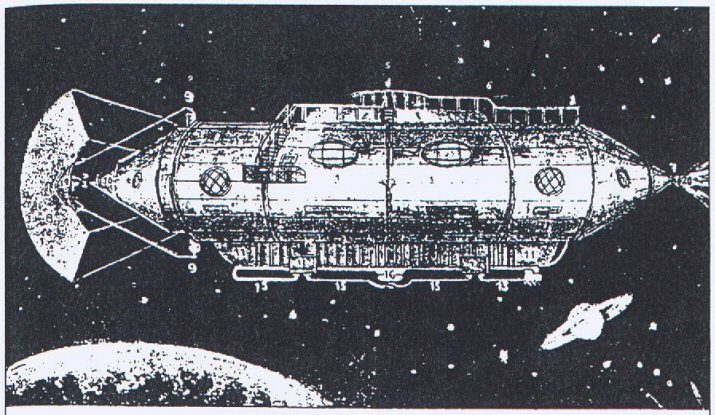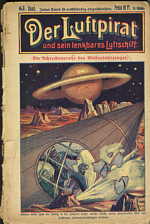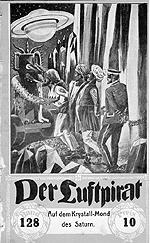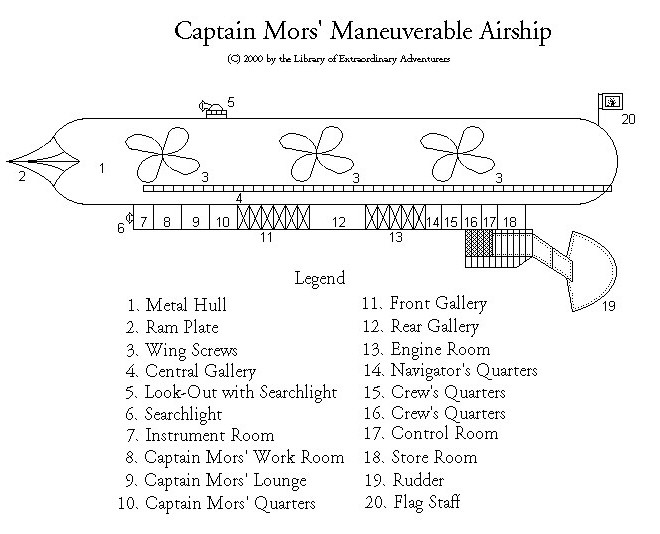
The Captain Mors Page
by Jess Nevins

The Captain Mors Page
by Jess Nevins
The text here, except where otherwise credited, is © copyright 2001 Jess Nevins, and may not be duplicated, in part or in whole, without my permission.
Thanks to: Alicia, as always; John Clute; Justin Gilbert, Geoffrey Tolle, and H.J. Galle; John Burt.
Updated 5 August 2001
Captain Mors, aka der Luftpirat, was a fictional German hero from early in this century. This site is meant to provide information on him.
Der Luftpirat und sein Lenkbares Luftschiff. ["The Pirate of the Air and his Navigable Airship."] German Dime-Novel series, popularly known as Kapitän Mors der Luftpirat; it has no connection with a 1948 series of the same name. One of the most popular series of its day, its author or authors are unknown, but well known writers like Oskar Hoffmann (1866-?) may have been involved; and, since its adventures take place alternatively on Earth and in space, it may have been written by more two people. 165 32pp issues were published 1908-11, at first by the Druck- und Verlagsgesellschaft m.b.h. in Berlin and, retitled simply Der Luftpirat, from #94 by Verlag Moderner Lektüre, also in Berlin. In 1914 #65-#86 were republished as #1-#22 of the series Der Fliegerteufel, published by Verlag P. Lehmann G.m.b.h. in Berlin. During WW1 the series was proscribed by the military as "trash." DLusLL anticipates many space operas, having an interplanetary background--there are numerous adventures with Venusians, Martians, crystal robots, and monsters of all kinds on the planets of the Solar System. Many issues have blueprints of Mors's spaceship on the back cover. Captain Mors, the Man with the Mask, is a Nemo-like fugitive from mankind who, with his crew of Indians, fights against evil. There is a case for calling this the first sf magazine.Mr. Rottensteiner's description is fairly complete, as far as bibliographic information goes, and there's really not much more I can say about that end of things. Thanks to H.J. Galle I can say that contrary to what I originally wrote and contrary to the library entry at the University of California at San Diego, Frank Astor, another notable early German science fiction writer, did not write any of the Luftpirat stories. (As it turns out "Frank Astor," whose real name is Hans Günther, was credited with writing five stories of the 1948 Kapitan Mors Der Luftpirat series, but that series was actually the reprinting of the 1938 Detektiv Frank Romane series.)
(From page 740 of the Encyclopedia of Science Fiction (Clute and Nicholls, eds, 1993) Written by Franz Rottensteiner. © copyright 2001 John Clute and Peter Nicholls. Reprinted here with the kind permission of Mr. Clute)
The passage above, modified somewhat from its first appearance in the earlier version of the Encyclopedia of Science Fiction, contains about all the information that is available, in English, on Captain Mors.
 However,
I find Captain Mors a very interesting figure in a number of respects,
and so am trying to provide slightly more information than this, in the
hopes that others will find him as interesting as I do and will search
his stories out, and (better still) contribute information to me.
However,
I find Captain Mors a very interesting figure in a number of respects,
and so am trying to provide slightly more information than this, in the
hopes that others will find him as interesting as I do and will search
his stories out, and (better still) contribute information to me.
Captain Mors is, as mentioned, a Nemo-like former submarine captain; a genius "centuries before his time," he wears a domino mask over his mustachioed face and travels around the Earth and through out the solar system in his "mysterious, dirigible air ship." He is a brilliant engineer who was responsible for building the ship. (The details of his origin and of the building of his ship were never explicitly laid out, as far as I know) The ship, the Meteor--you can see what it looks like in the illustration here and below--is powered by "the terrifying solar energy" which is "otherwise only...used by alien beings." The Meteor is heavily armored (proof against artillery shells) and air-tight, with oval windows and doors on the nautical ship model, all of which are crossed with bars and can be locked via thrown metal bolts. The Meteor is steered by a "giant magnet," has an "air supply mechanism," "liquid air tubes," a "force generator," and an "electricity container." The magnet also controls the gravity on the ship. The Meteor's front is an enormous, very sharp ram, and it is armed with "heavy cannons" and air-to-air missiles.
While The Meteor is definitely not the first fictional spaceship, or even the first whose description was given in more than general terms, The Meteor was given the most attention of any of the fictional spaceships to that time, with diagrams such as the one above and long passages devoted to the details of The Meteor's operation.
Justin Gilbert, who is in large part responsible for this page existing at all, sent along the following, revising the preceding:
Mors had several different kinds of flying craft. The first was the maneuverable airship (lenkbares Luftschiff). This is the one we are introduced to in the first issue. It seems to be not that different from real dirigibles, except that it is made from some strange metal and is therefore impervious to missiles, and that it is larger and faster than any other dirigible. This is the vehicle with the ram, which he uses to sink a ship in the first story. This is also the ship shown in the diagram which Geoffrey cleaned up.Then there is the Meteor. You show a picture of this as well. Your page gives the impression that this is the same as the airship, but it is not. The Meteor is a Weltenfahrzeug. Literally translates this means "worlds-craft," i.e. a craft that can travel to other worlds. But after discussing this with Geoffrey I just translated this as "spacecraft." While I think this sounds a little too prosaic, I couldn't think of anything better. By the way, the German word for spacecraft is Raumschiff. I don't know whether the author(s) purposely didn't use this word, or whether it just didn't exist yet in 1908. The Meteor has a giant magnet in front, so it does not have a ram. It can also be used to travel within Earth's athmosphere, but is too fast and not as easily maneuverable, which is why Mors still uses the airship.
Then there are flying machines, Flugmaschinen. These are smaller and cannot, as far as I know, travel as far. They are used for short trips.
 Mors is
more of a Robin Hood figure than Nemo, ranging across the globe and the
inner and outer planets doing good deeds and helping the poor; with his
mixed Indian and European crew he fights against evil wherever he finds
it, despite being a wanted fugitive and having a distinctly misanthropic
attitude towards humanity. This crew includes Star and Terror, the "reliable
and intrepid" engineers, an imprisoned astronomy professor whose calculations
and knowledge are often useful to the crew and to Mors, and Lindo, the
young Indian who idolizes Mors and who Mors treats like a favored son.
After a failed mutiny Mors left the mutineers behind on Earth, so the remaining
crew is very loyal to Mors. For his part he treats them very informally
and shows them great fairness and affection. Mors has no love interest;
his beloved wife has been "wrested from him by destiny," and his heart
is dead to all other women. (This is why he wears the mask) To quote Manfred
Nagl in his Science Fiction in Deutschland (1972),
Mors is
more of a Robin Hood figure than Nemo, ranging across the globe and the
inner and outer planets doing good deeds and helping the poor; with his
mixed Indian and European crew he fights against evil wherever he finds
it, despite being a wanted fugitive and having a distinctly misanthropic
attitude towards humanity. This crew includes Star and Terror, the "reliable
and intrepid" engineers, an imprisoned astronomy professor whose calculations
and knowledge are often useful to the crew and to Mors, and Lindo, the
young Indian who idolizes Mors and who Mors treats like a favored son.
After a failed mutiny Mors left the mutineers behind on Earth, so the remaining
crew is very loyal to Mors. For his part he treats them very informally
and shows them great fairness and affection. Mors has no love interest;
his beloved wife has been "wrested from him by destiny," and his heart
is dead to all other women. (This is why he wears the mask) To quote Manfred
Nagl in his Science Fiction in Deutschland (1972),
Through his courage and his coldbloodedness, his technical competence and his brilliant inventions, but also through his Herculean strength, he is legitimized as an indisputable leader. He isn't afraid of death and doesn't lose his cold, calculated calm in life-threatening, seemingly hopeless situations. He's ready to risk his life for his friends and for his crew every time.
 Mors is described
in issue #102, Death in Outer Space, in this way:
Mors is described
in issue #102, Death in Outer Space, in this way:
And just as Verne's mysterious Captain Nemo once ruled the seas, Captain Mors now rules the air with his mysterious air ship.Mors comes into conflict with a variety of aliens, including Venusians, Martians, crystal robots (who use "strange devices"), and various extraordinary monsters, which are inevitably "slimy" and "terrifying." Mors also discovers new planets, such as in #42, In the Deadly Crater of the New Planet, where a small planet, orbiting between the Moon and the Earth, is found. Mors and his crew land on the new planet and find it to be in an evolutionary stage similar to Earth's Jurassic era, and is full of heavy volcanic activity, and dinosaur- and snake-like monsters. The latter are fought with the swords, knives, and axes that are the crew's weaponry. Through all the stories shines Mors' love of "Mother Earth," which must be defended by the unending threats of a hostile universe. As the issues go by, his Nemo-like alienation from human society fades and he becomes a more uncomplicated hero than the misanthropic figure seen in "The Ruler of the Ocean of the Air." Mors never loses his capacity for bloodshed and war, but his distaste for humanity is replaced, despite his personal history, with a more humanitarian love, although he remains capable of great violence when necessary.And the world calls him the Pirate of the Air!
Why?
Captain Mors tears the ill-gotten gains from those who make enormous fortunes solely through the power of capital, and gives it to the poor and destitute. Thus he relieves poverty and misery with these treasures. The Pirate of the Air protects the persecuted innocents, he punishes insidious criminals...
Nothing can be hidden from him!
A number of the most wonderful adventures that any human being ever experienced take place before the reader's eyes. Abundant with touching situations, told with imagination and executed with boldness, the adventures of the Pirate of the Air guarantee entertaining and instructive reading.
(Quoted in Franz Rottensteiner's The Science Fiction Book: An Illustrated History, 1975)
As an added bonus, many issues have the blueprints of Mors' spaceship on the back cover. The diagram below, a cleaned-up version of the one in the original issues, is provided courtesy of Geoffrey Tolle.

Its Place in Science Fiction History
Der Luftpirat is not, exactly, an important magazine in the history of science fiction. It has been argued in the past that Der Luftpirat und sein Lenkbares Luftschiff constitutes the first serial space opera or the first science fiction magazine, but as I'm about to address I don't believe either to be the case. But the magazine and the figure of Captain Mors do hold a certain attraction (else why would it still be remembered when so many other, similarly Nemo-esque characters have been forgotten?), and so I'm doing this page.
The history of science fiction is no simple subject, to be dealt with even briefly. I'll instead restrict myself to some comments on the history of science fiction magazines and and space operas and comment in that way on Der Luftpirat's place in the history of science fiction.
"Space opera," for those of you not in the know, is a play on "horse opera," a phrase used to describe Westerns. When applied to science fiction, it can mean either a "hacky, grinding, stinking, outworn spaceship yarn," if you believe Wilson Tucker, or (in the words of Brian Stapleford) "colourful action-adventure stories of interplanetary or interstellar conflict." The first true space opera was E.E. "Doc" Smith's The Skylark of Space, written in 1928 and featuring the heroic scientist Richard Seaton's battles against his evil rival "Blackie" DuQuesne across many worlds. Written at approximately the same time was Edmond Hamilton's stories in Weird Tales, including "The Universe Wreckers" (1930). Between these two, and writers like Ray Cummings (whose space operas predated Smith's, but whose reputation was made in stories on the microscopic, rather than macroscopic, scale), John W. Campbell, Jr., and Jack Williamson, the space opera became one of the dominant sub-genres of science fiction for the next two months.
But as with so many other fictional firsts, The Skylark of Space had a number other predecessors. There were a large number of other fictional trips into space during the 19th century, written by Jules Verne as well as other authors, American, British, French and German. And there were also what would now be thought of as science fiction magazines. During the 19th century there were a number of dime novels, featuring characters like Tom Edison, Jr., Frank Reade, Jr., and Electric Bob, which contained large elements of the techno-fantastic. Whether these were actually science fiction or science fantasy is a matter I'm not going to delve into, but these characters' adventures did lay the groundwork for (or at least anticipate) the later science fiction magazines.
More blatantly science fictional magazines and characters appeared in the 20th century. In Germany one of the first, if not the first, was Oskar Hoffmann's Mac Milfords Reisen im Universum. Von der Terra zur Luna oder Unter den Seleniten. Astronomische Erzählung (Mac Milford's Trip Through the Universe. From the Earth to the Moon or Beneath the Men of Mars. Astronomical Story), a 1902 dime novel series in which heroic Scots astronomer, scientist, and adventurer Mac Milford goes into space and explores the solar system, meeting aliens all the while. In France 1905 saw the publication of Le Docteur Oméga - Aventures Fantastiques de Trois Français dans la Planète Mars (Dr. Omega - Fantastic Adventures Of Three Frenchmen On Planet Mars), about Dr. Omega, an adventurer-inventor who travels to Mars in a spaceship of his own invention. French writer Henri Gayar, in 1908, wrote Les Aventures Merveilleuses de Serge Myrandhal sur la Planète Mars (The Wonderful Adventures of Serge Myrandhal on the Planet Mars), about an inventor who takes his spaceship to Mars and fights aliens there.
In light of these examples, and there are others just like them that
I've excluded, I can't credit Der Luftpirat with being either the
first science fiction magazine or the first serial space opera. However,
as Mr. Rottensteiner points out in his description, quoted at the top of
this page, Der Luftpirat does anticipate the space operas to come.
Der
Luftpirat also expanded the scope of the space voyage tales, so that
going to one planet was no longer enough; many different planets and aliens
would be met (and fought) in the course of a series.
Issues
Issues of Der Luftpirat und sein Lenkbares Luftschiff are, as might be expected, rare and hard to come by. According to noted German collector Heinz-Jürgen Ehrig, only one collector in Germany has a complete run of the series. The others are split up, in the hands of private collectors or in libraries. I myself have never seen an original issue, and as far as I know the only original issues in the United States are at the University of California at San Diego, which is a long way from where I am now.
However, thanks to the very generous efforts and contributions of Justin Gilbert, gentleman, scholar, and moderator of the Blood and Dime Novels mailing list, I can provide not one but two translated e-texts, of issue #1 and issue #156. Justin has a few other issues that he will, as time permits, translate for me (my German is barely above dictionary-translation level, while his is much superior), and I will, with his permission, post them here as I receive them. I also hope to eventually get photocopies of the issues in San Diego and translate them or have them translated. And, who knows, perhaps some kind collector will stumble upon this page and willingly donate copies of an issue or two. I would like this site to eventually be the site on the Web for people to go to for information on Captain Mors and for e-texts of his issues, and I trust that, in the months and years to come, I will at least partially achieve this goal.
#1 The Ruler of the
Ocean of the Air
#2 A Fight for Millions
#3 Captain Mors in India
#4 The Air Pirate in the Diamond Countries
#5 Adventures in an Unknown Land
#6 The Treasure of the Flaming Mountain
#7 The Secret of the Japanese
#8 The Manchurian Mutineers
#9 The Mysterious Island of Captain Mors
#10 The Uncanny Engineer
#11 The Airship in the Whirlwind
#12 A Battle in the Air
#13 The Mysterious Mine of Captain Mors
#14 The Ivory Treasure in the Polar Sea
#15 The Malaysians' Revenge
#16 Captain Mors, Imprisoned
#17 A Duel Between Earth and Sky
#18 Captain Mors and the Traitor
#19 The Uncanny Skyscraper
#20 The Wealthy Treasure of the Tower of the Tyrant
#21 The Prisoners of Devil's Island
#22 Captain Mors' Saddest Hour
#23 The Secret of the Mountain Lock
#24 The Governor's Revenge
#25 The Rocks of Death
#26 The Ghostly Saboteur of the Schaho Railway
#27 The Mountain of Gold in the Coral Sea
#28 The Explosive of the Ancient Mongolian Wizards
#29 The Diamond Field of the Transvaal
#30 The Spy on the Airship
#31 The Riddle of Mount Sulioten
#32 Captain Mors' First Trip in the Spaceship
#33 The Airship in the Ghost Mountains
#34 Captain Mors in the Meteor Shower
#35 In Battle with the Japanese Airship
#36 A Death Trip
#37 On the Rails of the Desolation Highway
#38 Captain Mors' Enemy in Space
#39 The Mysterious Destruction Machine
#40 The Rebellion on the Spaceship
#41 A Battle Between Spaceships
#42 In the New Planet's Death Crater
#43 The Air Pirate Under the Sea
#44 In the Sphere of Annihilation
#45 Between Merciless Enemies
#46 The Secrets of the Meteorite
#47 The Tower of the Death of Damascus
#48 The Mysterious Flight Machine
#49 In Pursuit of the Fire Planet
#50 The Air Pirate at the North Pole
#51 Captain Mors' Deadliest Enemy, Destroyed
#52 The Battle with People of the War Planet
#53 The Air Pirate and the Forest Robbery
#54 A Desperate Battle in Space
#55 The Air Pirate at the Earthquake of Messina
#56 The Spaceship on the Planet of Giants
#57 A Duel Above the Clouds
#58 A Rebellion in the Celestial Sphere
#59 The Unnatural Blast Furnace
#60 Adventure in the World of Death
#61 The Annihilation Battle in the Sky
#62 The Mysterious House on the Moon
#63 The Spaceship's Frightening Trip
#64 The Death Trip on the Canals of Mars
#65 The Air Pirate on the Eiffel Tower
#66 The Spaceship Between the Giant Comets
#67 The Fire Mountain of the Mystery Planet
#68 The Crater Lakes of the Unknown World
#69 The American's Phantom Air Ship
#70 The Mysterious Enemies of Captain Mors
#71 The Emperors' Night Ship
#72 The Downfall of the Mystery Planet
#73 Chained on a Burning Balloon
#74 The Kidnapped Princess
#75 The Air Pirate's Most Terrible Battle
#76 The Riddle of the Invisible Planet
#77 The Strange Armored Air Ship
#78 In the Terrifying World
#79 The Duel of the Air Ships
#80 The Temple in the Moonscape of Pluto
#81 The Secrets of the Air Pirate
#82 The Aviation of the Metal Disc
#83 In the Claws of Death
#84 At the End of the Sun World
#85 The Mind Forest of Manchuria
#86 The Last Trip of the Spaceship
#87 Between Life and Death
#88 The Mysterious Mine Under the Sea
#89 Captain Mors Battling the Mutineer
#90 The Hunt for the Document Folder
#91 A Fight for Dominion of the Skies
#92 The Deadly Secret Alliance
#93 The Rebel General and His Sacrifice
#94 The Death's Head in the Cabin
#95 The Phantom Canyon of Arizona
#96 War Ship and Flight Machine
#97 A Last Minute Rescue
#98 The Revenge of a Woman
#99 The Mysterious Air Balloon
#100 Adventure in the Country of Freedom
#101 The Mysterious Alaskan Gold Mine
#102 Death in Outer Space
#103 The Island of the Haunts
#104 A Decisive Battle in the Clouds
#105 The Rajah's Daughter
#106 The Terrors of the Sudan
#107 The Missing Expedition to the North Pole
#108 The Secret of the Decayed Lock
#109 In the Flaming Tail of Halley's Comet
#110 The Flying Machine in the Sea Waves
#111 The Leader of the Free Mountain People
#112 The Secret of the Moon World
#113 In the Wilderness of Siberia
#114 The Denver Lynch Court
#115 The Enemies of the Earth Men
#116 The Death Trip with the Insane
#117 The Frights of the Sierra
#118 The Selenite Fortress on the Moon
#119 The Mysterious Flight Machine
#120 The Trip into the Overworld
#121 The Mutiny on the Airship
#122 The Secrets of the Planet Mars
#123 The Convicts' Island in the Quiet
#124 Into Mars with the Armored Ship
#125 At the Threshold of Death
#126 Adventure on the Volcano Planet
#127 The Air Fleet and its Besieger
#128 On the Crystal Moon of Saturn
#129 The Air Ship Station in the Wilderness
#130 The Mysterious Detective
#131 The Secret of the Black Rocks
#132 The Trip Through the Asteroid's Tail
#133 The Air Ship of the Fog Mountains
#134 The Signal Station in the Moon Crater Cassini
#135 The Riddle of Devil Island
#136 The Missing Persons of Mars
#137 The Treasure in the Old Spanish Mine
#138 The Mysterious Moon Crater
#139 Between Earth and Sky
#140 In the Oversea of the Farthest Planet
#141 The Railway Train in the Burning Forest
#142 The Spaceship in the Valley of Horrors
#143 The Pearl Treasure of the Indian Ocean
#144 The Chase Across the Fire Planet
#145 The Renunciation of the Secret Society
#146 In the Empire of Eternal Death
#147 In the Middle of the Unleashed Forces of Nature
#148 In the Deserts of Mars
#149 The Tiger Tower on the Mountain of Death
#150 The False God's Fortress in the Moon Crater
#151 Captain Mors and the Night Horseman
#152 The Faerie Glacier of Nanda-Devi
#153 The Airship in the Tundra
#154 The Fearful Hour of the Air Pirate
#155 The Secret Policeman's Ambush
#156 Adrift in Outer
Space
#157 The Journey
into Destruction
#158 The Downfall of the Spaceship
#159 In the Grip of the Glacier's Ice
#160 The War for the Airship Model
#161 Between Life and Death
#162 The Mysterious Spaceship
#163 The Deathmatch in the Airship
#164 In Battle with the Demon
#165 The Hour of the Decision